- Keeney Ten Pins (1949)
- Bowl-a-rama (United 1960)
- MBA (MBA 1960)
- 1963-1969 Bally Bowlers
- King Pin (CCM 1951)
- Skee-Ball-Ette (Gottlieb 1940)
- Ski-Ball (Evans 1940)
- In the Barrel (Evans 1940)
- Evans Ten Strike (Evans 1939-1953)
- Rockola 10 Pins (1940-1941)
- United & Chicago Coin Ball Bowlers (expecially if located in Michigan or northwest Ohio/Indiana)
and Shuffle Alley History & Evolution
07/02/19, cfh@provide.net
Copyright 2001-2017, all rights reserved.
I Collect/Buy Bowlers.
Some specific bowlers I am looking for include:
How to find a game easily in this document:
This document is organized alphabetically by game type. To
easily find a particular game, use the CTRL-F function of your browser,
and type in part or all of the game's name to search this document.
Bowler Parts and Schematics.
Yes I collect bowling games by United, Chicago Coin and Bally! If you have
a ball bowler for sale (particularly in the Michigan area), please contact me by
email at
cfh@provide.net
I can arrange shipping from nearly anywhere within North America.
I buy ball bowlers from 1957 to 1970 ball bowlers
(bowling alleys) by United, Williams and Chicago Coin Machines (Chicago Dynamics Industries,
aka CDI). These are more difficult to ship, but often it
is possible (please contact me if you have one for sale, and where
the game is located - I am near Detroit, Michigan.)
Sorry I do not have any sources for other bowler parts or schematics
(other than the suppliers found at the
parts and repair sources web page).
And I can not help find bowling games, as these things are huge
(the best way to find one is to look in your local area at "amusement" type stores).
Information on repair of these games can be found
below and at
PinRepair.com/em.
-
This document covers post-WW2 and later bowling games (mostly United/Williams and
Chicago Coin, but also Bally and some other brands too).
There are some other styles of games here, which loosely following a
bowling theme (i.e. they have a ball or a puck which is launched down
an alley). This includes some Skee-Ball, Shuffle Targettes, Bouncing Ball Shuffles,
and other oddities. But all
games listed here basically have one thing in common; they either use a ball or a
puck, which is hurled by the player down an alley.
During the 1950s bowling was a big American past time. To capitalize on this trend, United invented (and other companies copied) coin operated versions of bowling. These games typically were not in bowling alleys (but sometimes were, for those wanting a quick game of bowling, without shoe rentals!), but were in arcades and corner bars.
The Marriage of Seeburg, United and Williams.
In June 1964, the Seeburg corporation (of Jukebox fame) bought
the Williams Electronic Manufacturing
Corporation. Seeburg operated Williams as a fully owned subsidiary, with
Williams continuing its amusement machine production and
maintained its distribution system.
In buying Williams, Seeburg acquired all the issued and outstanding
shares of capital stock from the firm's two shareholders, Samuel Stern
and Bernard Weinberg.
"Shuffle-Alley", in October 1949.
(taken from a October 1949 Empire
Coin Machine advertisement).
An add-on "disappearing pin" unit
was also available (not shown).
This device added mini-pins that
flipped up as the puck hit the
alley rollover switches.
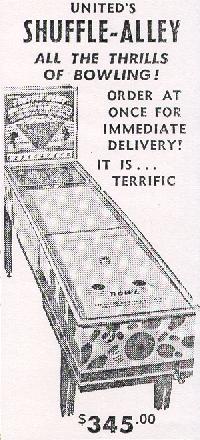
Only three months later (September 1964), Seeburg bought United's game assets. Sam Stern, president of Seeburg's Williams subsidiary, ran the United operation and retain his duties with Williams.
Seeburg began its acquisition strategy in 1958 with the purchase of the Bert Mills Coffee machine. Later purchases included the Lyons cold drink machine, the Bally hot drink machine, the Pic-a-Pack utility vender, the Kinsman Organ Company, the Choice-vend and Cavalier bottle and can drink machines, the Du Grenier cigaret machine, and of course the Williams and United game lines. These acquisitions made Seeburg a full circle manufacturer of coin-operated equipment including jukeboxes, vending machines, and amusement games (pinball, bowlers, etc).
While United has made many types of amusement machines, its bowling games and shuffle alleys have been primarily responsible for its reputation. Williams was strongest in the pinball and baseball machine lines.
-
On October 31, 1964, Williams announced their move to the larger United
plant at 3401 N. California avenue, Chicago. Williams still owns this
plant today (where slot machines are developed, but all Williams production
has been moved to a new plant in Waukegan, IL).
-
Because of the marriage of United and Williams, starting about 1965 or 1966 United bowlers
also have a Williams manufacturing company logo and address on "United" bowlers.
Even though after September 1964 United existed in name only, Williams continued
to use the "United" name because of their reputation as making the best bowling games
(this information came from 1964
Billboard magazine articles).
As late as the 1983, Williams was still using the United name on their
Shuffle alleys (1983's Triple Strike
was the last shuffle with the "United" name).
Unfortunately, in 1999 Williams stopped making all amusement devices (they only
make slot machines now, under the Williams name).
|
Chicago Coin's "lazy susan" swivel score rack that allowed the game to be serviced from either side, without moving a game from against a rear wall. It was a great repair idea, but the cabeinet sure was ugly! First used in 1965 on Super Sonic. |
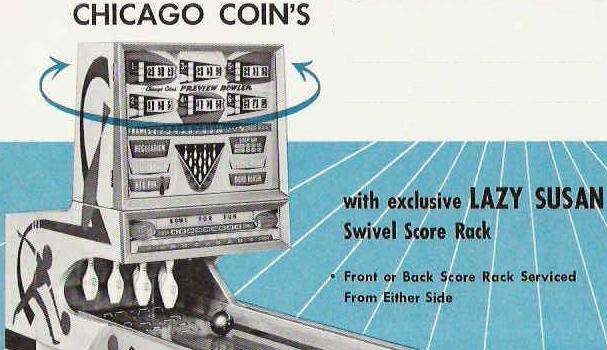
|
Pre-1950 Bowling Innovations.
-
Prior to 1950, there were really some cool bowling games
that were quite innovative. For example the
1939 Bally Alley, which used
a rotating ball to do a "spin out" down the lane.
This concept was later revived with the
1958 United Midget Alley.)
And the first version of the "ten strike" came in 1939 with
Evans (this classic was revived many
times until 1971.) Another interesting pre-1950 bowler was the
1949 Keeney Ten Pins - this game took
the Evans Ten Strike game one step further making it larger,
and creating the first try contact ball bowler.
(Or What's a Good Ball Bowler to Own?)
-
The reason for CCM and United bowlers is simple; I like them the best!
As a friend of mine puts it (he likes Bally bowlers), it's
a "Ford versus Chevy" type arguement. But I feel the
quality, looks, and ease of repair is better with United and CCM
bowlers. This is especially true if you are an EM pinball
repair person. The mechanisms and game logic of Chicago Coin and
United bowlers (and after 1964, United/Williams) will be very familar.
Bally bowlers are more foreign and don't
make as much sense to the typical EM pinball repair guy.
Also many Bally bowlers have much of the EM modules under
the lanes, making them more difficult (back pain) to work on.
Note there are some exceptions to the Bally rule (like the 1963-1969 Bally
Bowlers, which really rock.)
Chicago Coin (Chicago Coin Machines or CCM, a division of Chicago Dynamics Industries aka CDI) made lots of bowling games. Generally speaking I find CCM games to be of comparible (or even better) quality to United. I like the CCM pinset units much better than United - they reset and retract with more solid motion (United pins "wooble" much more, looking cheap and toyish). This gives CCM ball bowlers a more solid look and play feel. Also the lane step-up on CCM games used four legs instead of United's two legs. This makes assembling a CCM ball bowler easier, and the game is more robust in construction. As a rule, Chicago Coin games were less expensive (retail price when new) than other makers. And hence, the quality of their electrical components was a bit lower. For example, the plastic score motor cams. These are a major problem as the cams like to crack where they attach to the score motor shaft, rendering the game useless. Finding replacements in good condition is difficult too. (But a piece of copper pipe drilled for the lock screw and put over the cracked cam works great for a repair.) Also CCM stepper units are often painted opposed to being zinc plated like United games, so rust can be an issue. But these are minor issues. United games have problems with lane warp and pin "bowties", where CCM games don't have these problems.
As for looks, United's 1957 to 1960 games are hard to beat, and their quality is quite good, probably better than CCM. But from 1961 to 1964, I prefer CCM games for looks and play. Also CCM bowlers are feature rich, with good play action and fun options. And they were less expensive at their release, so there is a good supply of these fun playing CCM ball bowlers out there. Because of this I really like CCM ball bowlers prior to 1965. From 1965 to 1973, none of the bowlers look good! The CCM "lazy susan swivel" score rack cabinet style (used from 1965 CCM Super Sonic to their last EM ball bowler Gold Medal in 1973) and the United/Williams rectangle pinhood games (1963 United Fury to their last ball bowler in 1970) are all basically ugly with bad backglass and cabinet artwork and styling. The pre-1965 CCM games (with 1964 CCM Majestic and CCM Cadillac being the 'end of the line') are great games with nice natural oak trim, handsome looks, and feature-rich games. To me, the 1964 CCM Majestic and 1962 CCM Royal Crown are the big ball bowler for looks, play, features, and repairability. But even the 1965 to 1973 CCM bowlers are good games, maybe not as good looking, but still good games. (I have to admit, the CCM lazy susan head makes repair *way* easier than any United or Bally game.)
Bally bowlers have a number of cosmetic features I just don't personally like as much. For example, the metal pin guard, and general look and styling of their bowlers. They just appear a bit industrial to me. Bally used cheaper hardwoods like Poplar and stained them dark, opposed to United and CCM which used nice Oak and stained it natural (or pickled white) so you could see the grain. There are also some repair issues on Bally games that are not problems on CCM or United bowlers. This includes bad connectors, bad lamp sockets, and bad fuse holders on Ballys (though fuse holders are no big deal as they are easy to replace, but the connectors and lamp sockets are more time consuming.) The lamp sockets and fuse holders can be purchased new and replaced, but it just takes time to replace them. The reason these parts were lower quality was Bally made these components in-house, instead of buying them from companies that specialized in making connectors and sockets. Because of this, Bally lamp sockets, connectors, and fuse holders will often need to be replaced, which makes restoring a Bally bowler generally more work. Finally, the EM logic Bally used for scoring with their "director unit" and mark storage relays can be a bit more difficult to troubleshoot. And many Bally bowlers have the EM modules under the lane, which can cause back pain when repairing. The upside to Bally bowlers is their speed of scoring. United and CCM games often have a "Do Not Bowl When Lit" light. This allows the games to score and cycle between frames. Bally bowlers usually do not have this as they score very fast, allowing the player to bowl as fast as the balls are returned to the player.
Bally also had some unique ideas in bowlers, like Bally's 1964 Bally Bowler, 1965 Bally Bowler and 1966 Bally Bowler and 1969 Bally Bowler. These three games used a unique "swivel action" reciprocating pins, which allowed the pins to move in any direction (not just backwards like the linear United/CCM games). Unfortunately parts for these (often broken) pins are difficult to find, which presents a problem. But on the other hand, these Bally bowlers are probably the best all around contact ball bowler for realism. Only the 1960 United Bowlarama comes close to these Bally machines for real contact bowling.
Another thing that contributes to the popularity of United and CCM bowlers over Bally is just the sear numbers. Bally stopped making bowlers altogether by 1969, but any Bally bowler after 1959 is pretty rare. United and CCM made bowlers into the 1970s. So there are just a lot more United and CCM bowlers out there, and parts are easier to get. Also United and CCM bowlers of the 1960s are more feature-rich with multiple games. (Bally never got into the 6-game styles that United and CCM used.)
Types of Bowling Games.
Essentially there are "Puck Bowlers" (aka "Shuffle Alleys")
and "Ball Bowlers" (aka "Bowling Alleys"), and there are some other variant
bowling games too (discussed below). Most bowlers (shuffle or ball) are six player games.
United Manufacturing was the premier maker of coin operated bowling
and shuffle alley games during their history. There were other companies making
these games (Chicago Coin and Bally for example), but United made the bulk of them (and
probably the best games too).
|
United "first facts"; bragging about the first shuffle alley called "Shuffle-Alley" in October 1949. |
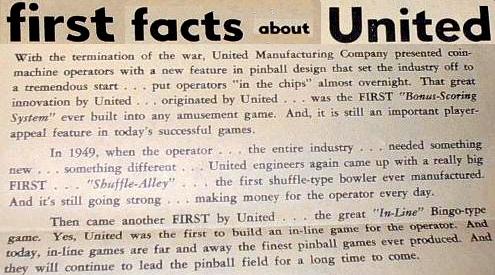
|
Shuffle Alleys (aka "Puck Bowlers").
-
A shuffle alley has a 4 to 9 foot long alley with bowling pins at the end of it.
The player knocks down the bowling pins with essentially a metal cased hockey puck
(hence the name Puck Bowler). The puck is slid down the alley and hits switches on
the alley (which causes a relay to pull in, allowing the sprung bowling pins to retract upward).
The puck was returned to the player by "bouncing" off a back rubber wall, and back up
the alley to the player. A common thing to see with these games is "alley wax" (Sun Glo),
which is not really a wax but looks like a layer of ground up corn cob.
This helps the shuffle puck slide down the alley. Shuffle alleys were
invented by United in October 1949 with the introduction of United's
"Shuffle-Alley" (10/49).
United continued to make shuffle alley all the way to the 1990s.
Shuffle alleys are the less desirable of the coin operated bowling games,
but most people can fit them in their basement (unlike the next type of bowler...)
|
United bragging about the first ball bowler call "Bowling Alley" in 1956. |
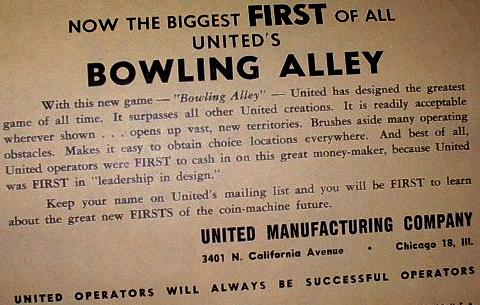
|
Bowling Alleys (aka "Ball Bowlers").
-
If you have a ball bowler for sale, please contact me at
cfh@provide.net.
The first ball bowler was introduced by United in November of 1956 ("Bowling Alley"). This game was significantly different than a shuffle alley (though it shared the same basic game rules). Chicago Coin and Bally introduced their own initial ball bowlers after United, in February 1957 ("Bowling League" and "A.B.C. Bowling Lane", respectively).
|
Bally's "swing away" pins, used on the 1963-1969 ball bowlers only. This was a great idea for ball bowlers. No rollover lane switches. The ball actually hits the pins, which in turns swivels and knocks up the other pins, just like real bowling. |
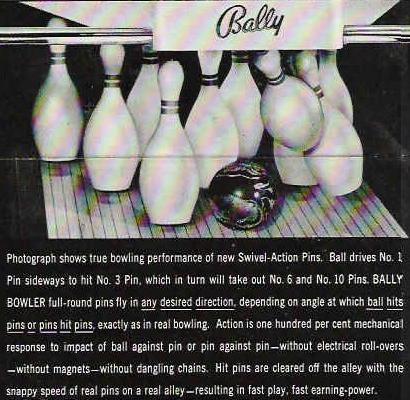
|
-
United ball bowlers started out at a whomping 14 feet in length
(typically, but 11 to 25 foot alleys were
also available). Later ball bowler were available in even longer lengths,
with Chicago Coin selling their later ball bowlers in lengths up
to 32 feet! (With added extensions.) The alley itself was about 18 inches
off the ground (later games were lower),
and the player actually rolled one ball (of the usual three balls in the game)
down the alley and hit bowling pins, just like real bowling.
How long should your ball bowler be? Well if you have unlimited space, the longer the better! But most people find that a 16 foot ball bowler is about right. The shorter 13 foot models with 4.5" balls seem too short (though shorter lanes do work well with balls smaller than 4.5 inches). The longer-than-17ft lanes are great, but most people don't have the real estate to dedicate to a ball bowler that long. Hence most people like the 15 to 17 foot games with 4.5" balls and multiple game options the best.
On 1957/1958 ball bowlers, the ball often directly hits the bottom of the bowling pins causing the spring loaded pins to move backward slightly and close a switch. This in turn activated a relay which fully retracted the hit spring-loaded pin. There are NO lane switches. This type of bowler is known as a "contact bowler", because the ball actually makes contact with the pins. But the problem with contact bowlers is the bottom of the pins wear out, causing them to not move when a ball rolls under them, and thus not scoring well. And the rubber that slows the ball after the pins often have some sort of switches to tell the game the ball is past the pins, and often these switch(es) or the rubber breaks making the game unplayable. Finally there is one or two switches for each pin located by the pin release relay (above the pins) that tell the game a pin has been hit. Because of these heavy usage switches, contact bowlers are harder to maintain and operate. Hence they were only used on a few ball (and shuffle) bowlers during 1957 and 1958. Also how the ball hits the pins and then how the pins are retracted gives a kind of "studdered" look to the pin retration. That is, the ball contact the pin moving it back about two inches. This closes a switch which tells the game to pull in the pin relay, causing the pin to then fully retract. There is a very slight delay in this process, making the pin retraction look unnatural (at least to my eye). It's not as smooth and single motioned as a lane switch bowler.
To solve these problem the manufacturers went back to the roll-over switches in the lane (each switch connects to a relay, which when pulled in, allows the respective sprung bowling pin to retract upward). Actually hitting the pins is more realistic, but also causes more potential long term damage to the game (the pins are plastic and often broke, and the pin contact switches got beat to death). Because of this, most ball bowlers use lane switches, which are lower maintainence and just generally work better. It's a bit of an optical illussion though, as the pins are placed an inch or so behind the rollover switch, and only retact when the lane switches are closed (and not by ball impact, but it LOOKS like ball impact is making the pins retract!)
The only true contact ball bowlers made was United Royal (11/57), Bally Lucky Alley (8/58), Bally Strike Bowler (11/57), CCM TV Bowling League (11/57), CCM Lucky Strike (1/58) and United Bowlarama/MBA (1960). Also some shuffle alleys were contact style too in 1957/1958. For the most part I don't see the big deal with contact bowlers - I actually don't mind the lane switches (there was a good reason the manufacturers did not make many contact bowler models).
CCM actually took the lane switch/contact bowler delema a step further with their 1963 Grand series of games. These games had the pins well above the ball, and separated by a small pin deck with formica lane material on the deck. It looks a bit funky at first, but functionally it's great. First there are no visible lane rollover switches, because the switches are *under* the mini-pindeck (making them "roll-under" switches). This gave a much cleaner look to the game. It also hides the ball-pit, again giving a clean look. And since the switches are a roll-under type, beer and pretzels don't get jammed in the switches (rendering the bowler broken). And finally the ball never hits the pins, so there's no broken or dirty pins to deal with. A very good solution to the problem, but CCM only used this system for a few games in 1962-1964. The problem was the visual aspect - it's not quite what you expect a bowler's pins to look like. Hence CCM went back to a standard lane rollover switch design in 1964 with Majestic (which by the way is one of the best CCM ball bowlers, a great looking and playing game). Here's a good picture to demonstrate the two styles of pindecks (the Majestic on the left has standard lane rollover switches, and the Grand Spare Lite on the right has the hidden rollunder style switches. Other than the two different styles of lane switches, these two bowlers are identical.
In 1963-1969 Bally used their unique "swing-away" pins, which were the best of all worlds - the ball hit the pins directly, and the pins swiveled in any direction, allowing them to hit adjacent pins. Unfortunately parts for these pins are difficult to find, and the games themselves are also very rare and not often seen. But they are among the best ball bowlers.
|
When buying a bowler, check for damage to the head on a bowler. This wood covers the pins from the top. The cracks happen because the wood is merely particle board, shaved and 'bent' to make the round front. Eventually it will break (unless reinforced from the back). The blue line in the picture shows another spot where the wood pin cover can crack. |
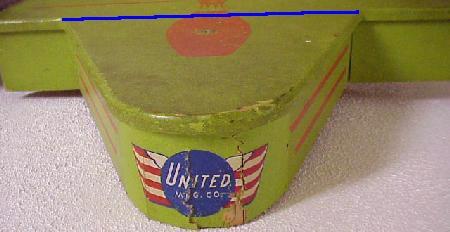
|
-
From November 1956 to November 1957, United ball bowler models used 3" composite balls
on their first four bowling alley games ('Bowling Alley', 'Team Bowling Alley',
'Hi-Score Bowling Alley', and 'Deluxe Bowling Alley'). Likewise
Chicago Coin and Bally also initially used 3" balls. Interestingly,
United and Bally 3" ball bowlers do not have gutters. By July of 1957,
Chicago Coin's second ball bowler ('Classic Bowling League') was the
first game to move to the larger 4 1/2" ball.
United started using 4 1/2" balls with their November 1957
'Royal Bowling Alley'. Bally made a more gradual change by moving game to game, from a
3" ('ABC Bowling Lane'), to a 3 1/2" ('ABC Tournament'), to a 4" ('ABC Champion'), to finally
a 4 1/2" ball in April 1958 for 'Trophy Bowler' and 'Lucky Alley' (8/58).
But for some reason, after Lucky Alley, Bally decreased their ball size
to 4" on Pan American (1/59) and Challenger (9/59).
But anyway, the larger 4" or 4 1/2" balls made the games
even more realistic. The added ball size allowed for more accurate throws,
and seemed more like real bowling. In 1966/1967 CCM even offered two models
(Vegas and Flair) with 6" balls!
|
A top view of the wood that covers the top side of the pins on a ball bowler. Also shown is the pin unit. Amazingly, there are no cracked or broken pins here! Cracked/broken pins are difficult to repair, as replacements usually do not match the other original pins. |
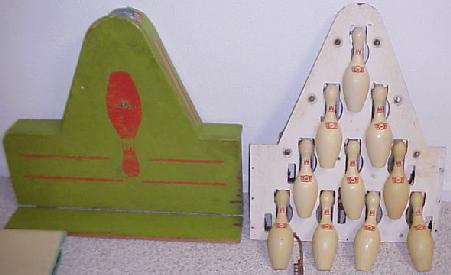
|
-
The other cool thing about ball bowlers is the way a ball is returned to the player.
There is an elevator style "ball lift" motor which lifts the ball up, and then rolls the ball down
an incline and back to the player up the alley. About 2 feet before the ball gets to the player, the
ball rolls up another incline, and comes to rest at the player's hand. This is just like a
real bowling alley, in that the player does not bend over to grab the ball.
As for styling and game play, personally I like the 1961 to 1964 games best. These games usually have multiple games ("Flash" being my favorite of the alternative-to-Regulation games) and 4.5" balls. By 1964 for United and 1965 for CCM, the games get really ugly in styling. Yes they are good playing games, but the classic looks of good backglass graphics, natural oak trim, and cabinet style/paint are gone.
|
A ball bowler ball hitting the pins on United's "Jumbo" ball bowler. This was largely an optical illusion, as the ball hits lane switches in front of the pins which electrically retracted the pins. |
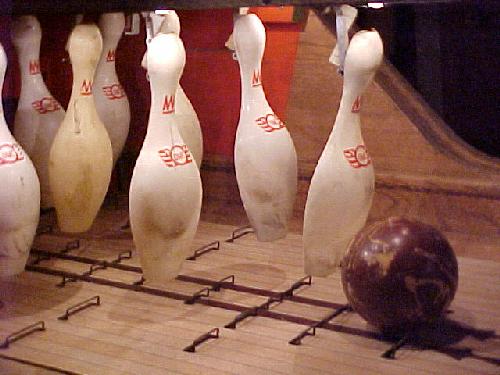
|
-
For bowling fans, ball bowlers are the real deal.
Of the coin operated bowling games, ball bowlers are
more desirable than shuffle alleys.
Unfortunately, Bally stopped making ball bowler in 1966, United in 1970,
and CCM in 1973. They just took up too much floor space
(even compared to shuffle alleys). There is even
a rumor that in the 1960s someone tried to sue United for
breaking their foot with a dropped ball bowler
ball. Also ball bowlers were expensive when new (much more expensive than
nearly any other coin operated device). For these reasons, 1970
(El Grande)
was the end of the line for United ball bowlers (and the second to last United
ball bower was
Coronado
in 1967, three years earlier). The other manufacturers
(Chicago Coin and Bally) also stopped making ball bowlers about
the same time (1973 for CCM). Solidstate ball bowlers did sparatically appear in the late 1970s,
but not very many models were ever introduced during the 1970s.
Chicago Coin had the last EM (Electro-Mechanical) ball bowler in 1973
called Gold Medal,
which used a shorter lane length to keep locations happier (one of
the complaints of ball bowlers were their size). But all the CCM ball bowlers
after about 1968 were generally all the same (just with different backglass
artwork). The last major manufacturer ball bowler
I can find made was the late 1970's solidstate (electronic, not EM)
Stern "Stars & Strikes".
|
A ball bowler's alley lane and ball return riser as seen by the player. Sometimes the lane warps. Click here for information on how to straighten a warped ball bowler lane. |
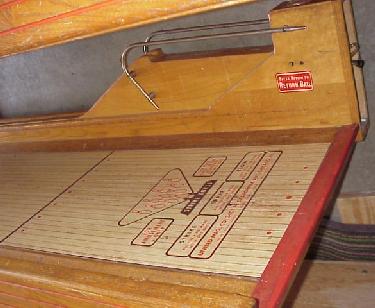
|
Roll Down Bowlers.
-
United (and later Chicago Coin) also sold a hybrid bowler that was a combination of a
Shuffle Alley and a Bowling Alley. These games had a shorter overall
length like a puck bowler (6 to 9.5 feet long), but used 1.5" to 3" diameter balls
instead of pucks. This hybrid bowler also
often used a ball lift motor to return to the ball
to the player, like a ball bowler. The ball is actually just let go by the
player, and it "rolls down" the tilted lane to the pins.
Some of these Roll Down bowlers included
Keeney Ten Pins (1949),
United Pixie Bowler (9/58),
United Circus (9/62),
United Silver (9/62),
CCM Variety (1/62).
CCM's Variety and United's Circus/Silver were the longest at 9.5 and 9 feet respectively,
and Pixie Bowler was 7.5 feet long. Though these game were smaller,
they were not very popular (or they would have made more of this hybrid bowling game!)
The rolldown games aren't really "bowling", so they didn't sell or earn as
well as ball bowlers or even shuffle alleys.
There was also another hybrid (really a predecessor) of the rolldown by United called Midget Alley (3/58). This game was unique in that it had a motor which spun a 2" composite ball at the player's end of the game. As the ball is spinning faster and faster, the player could aim the ball through a sort of moving sight. When the shot is lined up, a button is pressed releasing the ball on to the six foot alley, and the ball's spin then shot it at the pins. Midget Alley's ball release system was very unique and quite cool (and Midget Alley is a contact bowler). Another game that used this style of ball aim and release was Bally's "Bally Alley", made in the 1939 (not to be confused with the Bally Alley and Bally Lane wall games made in 1974). Bally Alley worked very similar to Midget Alley, but the pins flew to the sides instead of retracting above. Again, I am currently looking for one (please contact me at cfh@provide.net if you know of one for sale).
|
A "Roll Down" style bowler. |
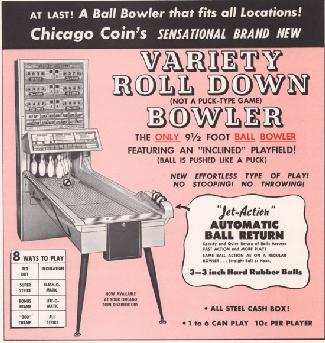
|
Shuffle Targettes (aka "Skee Alleys").
-
The Shuffle Targette (Skee alleys) was invented by United in
1950 (Skee Alley, 11/50). The Skee Targette was a cross between a Shuffle alley and Skee-Ball (see below).
The 1950 United Skee Alley,
1951 Twin Shuffle-cade Skee Alley, and
1954 Shuffle Targette Deluxe, used a small
metal puck which slide down an alley toward targets at the other end.
In place of bowling pins, Shuffle Targettes
used a bulls-eye-style target lined with open holes. A "lip" at the
end of the alley launched the puck up into the bulls-eye, earning different
amounts of points depending on where the puck fell. After a set number
of pucks had been played, the points were totaled.
These Shuffle Targettes were a big success, and United continued to make
shuffle targette games into the 1960’s.
These games were made mostly in the early 1950s, and are about as
collectible as Shuffle alleys.
|
United's first shuffle alley with score reels, the 1952 "Super Shuffle 6 Player" with it's pins revealed. |

|
Skee-Ball History and Description.
-
Skee-Balls are just like Skee Alleys, but instead of a metal puck, a small
ball is used (like a Ball bowler).
Skee-ball was invented in 1909 by J.D. Estes in the city of Philadelphia,
and obviously predates Skee-Alleys.
In 1914, Maurice Piesen marketed skee-ball to outdoor amusement parks.
In 1935 the rights to Skee-Ball were purchased by the Wurlitzer Corporation
from Maurice Piesen, and then Wurlitzer sold the rights to Philly Toboggan in 1945.
Hence Philadelphia Toboggan Company made a lot of skee ball games from the
1945 to the present.
When Skee-Ball alleys were first sold in 1914 to the outdoor amusement parks,
the games had a 36-foot lane. This was too long
for most arcades, so the length was changed to 14 feet. Eventually the
length changed again to the modern length of 10 feet (or sometimes 13 feet).
In 1974 Philladelphia Toboggan started making solidstate skeeball games.
And in 1977 Skee-Ball Inc. was formed from the old Philadelphia Toboggan Company.
Then in 1985 their skeeball machines now had electronic sound.
Philadelphia Toboggan Skeeball game.
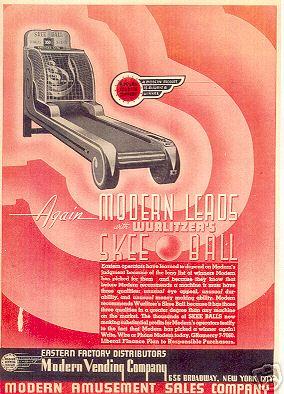
-
Traditionally skeeball games use wooden 3" balls. Usually there are nine to eleven balls
per game. Instead of knocking down
bowling pins, the idea is to bowl a ball down an alley, hitting a "lip",
which launched the ball into a target scoring hole.
The center bulls-eye target hole is the smallest and worth the most points, and is surrounded by
larger target holes worth less points (with a hole at the bottom, for a missed ball to fall).
Skeeball certainly has its fans. In today's amusement (redemption) centers, they are a mainstream ticket-spitting game. And since skeeball has been around for so long, many people remember them at arcades when they were a kid. ICE (Buffalo NY) sells modern skeeball games like Alley Roller, ICE Ball, and Dunk n Alien. Also the old Philadelphia Toboggan is now Skee-Ball Amusement Games, and sell new versions of their classic skeeball games.
Skee-Balls are not hugely collectible, and certainly not as collectible as Ball Bowlers. The reason? Well there's no mechanical action to them (no pins to hit and retract), so in that regard they are less desirable. But kids love them because the rules are very simple, yet the object (hitting the smallest bullseye hole) is difficult to achieve.
During the 1950s there were the few non-Philly made skeeball games like Genco Skill Ball (1956), CCM Tournament Ski-Ball (1957), CCM Ski-Score (1957), CCM Ski-Bowl (1957) and CCM Skee-Roll (1957). Notice none of these machines use "skee ball" in the name and the scoring is a bit different, due to potential problems with Philadelphia Toboggan. United didn't make any (they stuck to the skee-alley which used a puck instead of a ball), probably because they didn't want to deal with legal hassles of using skee-balls. I personally don't like any of the Philadelphia Toboggan Company skee-ball machines, as they don't have the quality of CCM or Genco machines (but the Philly Toboggan machines are pretty easy to find), and also don't have the interesting scoring.
|
A row of Skee-Balls in an old arcade. |
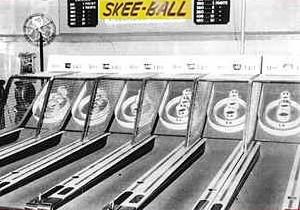
|
Bouncing Ball Shuffles.
-
As shuffle targette games continued to do well in the arcades, in 1958 United introduced a pair of
"bouncing ball" shuffle games:
Jupiter and
Shooting Star (Chicago Coin had its own
pair of bouncing ball alleys in 1958 as well, called
Rocket Shuffle
and Shuffle Explorer).
All four of these bouncing ball games played pretty much the same: Inside the machine’s
backbox was a 5x5 grid of holes. These holes were reflected by a mirror up into the backglass.
A handful of rubber balls were scattered randomly inside the head on the grid. The
object of the game was to line up these balls into three, four or five in-a-row.
As the shuffle puck hit spring targets at the end of the alley, the
corresponding row of balls was popped up into play, landing wherever they may.
Once the balls were lined up (or landed in the four corners), the player could
either press a button and take the bonus points, or continue to press their luck
for a better score. Collectibility of these games is somewhat limited too; most
people don't even know they exist!
Bowler Games and Scoring.
-
By the early 1960s, United and the other manufacturers had developed alternative
bowling scoring systems. Some games had as many as seven different scoring schemes,
which were user selectable at the start of a game. Probably the most innovative
scoring ideas came from Chicago Coin. Some scoring systems included:
- 30/20: Prior to 1956, nearly all bowlers used this scoring method - 30 points for a strike, 20 points for a spare. United changed to real "regulation" style scoring in 11/55 with Regulation Shuffle Alley, and most bowlers after this used regulation scoring. Electrically, the 30/20 point scoring involved less stepper units, so it is less sophisticated electrically. No frame carry-overs for strikes/spares.
- Regulation: AKA "A.B.C. bowling rules." Regulation bowling scoring (basically all bowlers 1956 and later have this, and a select few prior to 1956 like Gottlieb Bowlette used it too). Top score 300 points. Strikes/Spares carry-over to the next frame.
- Bonus: strikes and spares scored during the game build up to a potential "bonus" score. When the regular game ends, the play bowls an additional frame to collect the bonus. A strike earns all the bonus points, a spare gets half. Top score 9900.
- Advance: strike and spare values are fixed but advance. Usually start out 30/20, then 60/40, then 80/60, etc. No frame carry overs for strikes/spares.
- Progressive: strike and spare values increase (no carry overs to next frame). Basically a more advanced 30/20 scoring scheme and very similar (if not the same) as the above "Advance" scheme.
- Special: frames 1, 4 and 7 score 300 for a strike and 200 for a spare.
- All Strikes: on each frame, the machine presents each player with 10 pins to score. A strike is worth 300 points. Failing to get the "strike" scores only the pins hit. One shot per frame.
- All Spares: on each frame, the machine presents each player with a random set of pins to score. The game selects from 2 to 6 pins that each player has to hit to score the spare, earning 300 points. Failing to get the "spare" scores only the pins hit. One shot per frame.
- 300 Champ: two or more players only. Strike score 30, spare scores 20. Player continues to play as long as he continues to Strike. First player to get 300 points wins.
- Step-Up: Fixed scoring for strikes/spares (no carry-over), but values for strikes and spares step up as game progress.
- Add-a-Frame: After all players finish the 10th frame, players mayt shoot one, two or three added frames (as indicated on score glass). Strikes/spares are 30/20 points with no carry-over.
- Red Dot: game "randomly" associates zero, one, two, or three "red dots" to a frame. If no dots given, a 30/20 scoring is used. If the frame gets one red dot, 50/30 scoring is used, and so on (more dots equals more points). A randomized scoring feature. No frame carry-overs for strikes/spares.
- Flash: a traveling light on backglass/score hood registers changing values of strikes and spares. The player must time their first shot of the frame to get the most points (values range from 30/20 to 80/60). A great game of skill and timing. No carry-overs for strikes/spares.
- Dual Flash: Same thing as Flash but if player does not get a strike, the moving flash lights start again for the second shot of the frame. No carry-overs for strikes/spares.
- Line-Up: a type of Flash game, but incorporates a bingo grid into the flash scoring. Instead of 30/20 to 80/60 scores flashing across the pinhood, a 3x3 bingo matrix is used with single digit numbers "flashing". Player must time their shot to get the number desired. If a horizontal or vertical line is completed, the game awards extra points for 2-in-a-row or 3-in-a-row. No carry-overs.
- Shadow: "practice bowling like the professionals". Or better put, "bowl like Stevie Wonder." As CCM explains it, "Game plays without any visible pins. Object of game is to roll ball in strike zone as the pros do in shadow bowling without pins. If strike is not made, spare light on score glass indicates where to roll second ball. Game scores regulation." If the game has pin recorder lights, these go dark too. Though this game is really strange, it is a challenge (especially trying to get spares!)
|
United's 1956 "Bowling Alley" ball bowler advertising bumper sticker. |

|
Bowler Collectibility, Desirability, and Value.
-
Unrestored Shuffle and Skee Alleys (shuffle targettes) tend to sell
for a reasonable price ($0 to $500).
The size of the games, the difficulty in repair,
and the general lack of interest is to blame.
Ball Bowlers, back in their day, were considered "top end" coin operated models. They sold new for very big money back in the 1950s and 1960s (often $700 or $800 when new), and also made the operators good money. These games were also made like tanks, and many of them have survived. Today, these games can be collectible to the right person (with a BIG walk-out basement!) After all, who doesn't want a bowling alley in their basement? But the question when selling a 11 to 24 foot Ball Bowler isn't, "how much is it worth?" The bigger question is, "who can get this non-working monster out of my basement, and haul it away?" Because of this, unrestored Ball Bowlers tend to sell for a reasonable amount ($0 to $1000).
All Ball Bowlers and Shuffle Alleys effectively are difficult to impossible to ship, so a local buyer is often needed. This limits the price which can be asked (I am currently looking for one, so please contact me at cfh@provide.net if you know of one for sale in Michigan).
Case in point; a gentlemen called me with a 13 foot 1958 United ball bowler. The owner's dad worked for a wiring company in the 1950s that supplied wiring harnesses to United. In the christmas of 1958, a truck pulled up to his house, and out came a brand new 1958 United Bonus Bowler (thank the United Santa Claus!) The game remained in their basement the whole time. A "home use only" ball bowler (great condition!), but the game no longer worked, and the owners were moving.
The game needed to be removed, as the house was being sold. Also the basement was extremely small, and extraction of the bowler would be difficult. So the question to me was this; "what is the game worth?" My response was, "it doesn't really matter what the game is worth, you just need someone that is willing to take it out". And that was truely the case! Extraction of the game from the basement required three people, and took three hours! It was no small chore. The price for the game was $150. Given the work and people involved, the price paid might have been high! (The three people that moved the game complained they were sore for a week afterwards.)
Bowler Brands/Models - Which is Best?
The next question often asked is, "what is a 'good' bowler model?"
This of course is personal preference. I personally like ball bowlers (assuming
you have the 20+ feet of basement space needed!) Also I like the pre-1965
models, as those are still "wood rails" (lots of oak), and that use "big balls"
(4.5" balls). The 1957/1958 models often have smaller balls, and the post-1962
models have either limited artwork, and are more complicated
(difficult to repair). But the 1961 and later bowlers also have up to six different
games (I like Flash bowling a lot). So it's all about compromise. Do you want
more game variety (Regulation, Flash, All Strikes, etc), or classic looks and
artwork? Frankly the compromise I like best are the 1961-1964 CCM
ball bowlers, with the 1964 Majestic and
1963 Grand Spare Lite, and the 1962-1963 United bowlers like
Holiday and
Sahara being
the best balance of classic looks, lots of oak, 4.5" balls, and six+ games.
Another consideration is whether the ball/puck bowled actually hits the pins. On early United ball bowlers and most shuffle alleys, the ball or puck actually moves underneath the pins, where lane rollover switches are hit. If the ball/puck rolled over a lane switch, this engaged a relay which allowed that pin to go up (but the ball does *not* hit the pins). If the ball/puck hit a certain series of switches (perhaps the 1 and 2,3 pin switches and then a switch behind all the pins), this would register a strike, and all the pins would go up. Though this is good from a wear point of view (no broken pins!), they are not quite as realistic as a bowler where the ball/puck actually hits the pins themselves. On 1958-1960 games, United/CCM/Bally changed to a lane switch system where the ball actually hits the pins, but the lane rollover switch is what actually makes the pin retract. (Except on a couple games in 1958 where United used a "contact bowler" system to raise the pins. The pins would have a light spring which would allow the pin to move up about one inch or two. As the pin would move up from the impact of the ball, this would activate an overhead switch, which would energize a relay and raise the pin without using the force of the ball. This is a nice idea, as the reaction of the ball hitting the pin is what raises the pin, with help from the game. Also the lane was completely smooth with no proturding switches. Unfortunately this system required too much maintainence, and was changed to a lane switch style system. This is where the ball can graze the bottom of the pins, but the lane switch is what actually causes the pin to retract (and the pins should retract just before the ball hits it).
Then there's which bowler manufacturer to pick. As discussed above, this is largely personal preference. I like United and CCM bowlers best as I feel the quality and styling is top-notch. Bally bowlers feel strange to me personally, but the 1963-1969 units are perhaps the best ball bowlers ever made.
But no matter what style or brand of game you prefer, I'm sure you'll have fun. If you can fix one of these monsters and you have the space for it, they are quite entertaining and competitive. The ultimate party game!
-
The following ball bowler set up instructions came from the first United ball bowler, the 1956
"Bowling Alley" game:
- INSTALLATION: Fasten the four legs to the cabinet with the furnished bolts, using the painted outlines on the cabinet as a guide. Place back-box in position with furnished bolts and plug in connection jacks tight. Plug power line into AC only, 60 cycles, 115 volts. The power to this game is controlled by a toggle switch which is located under the front part of the cabinet.
- Place the four 3 inch diameter rubber balls into the game.
- In low voltage areas (105 volts or less), an additional boost in the output voltage of the transformer can be obtained by inserting the transformer voltage control fuse in the "LOW" line.
- To prevent abuse or cheating of this game, vibration switches are installed under the playboard and on the sides of the back box. Instructions for sensitivity are located adjacent to these switches.
- To make the playfield accessible for servicing, open the two locks at the left side, lift and rotate the top playfield clockwise to an upright position. The fall stop, which is part of the spring lift assembly, will lock when the board is lifted high enough. To lower the playfield, release the fall stop and reverse the procedure.
- To make the retractible pins accessible for servicing, remove the screw from the top of the hinged housing. This permits the opening of the hinged housing.
- STRIKE-CONTROL JACK: A rotary control jack is located in the cabinet which controls the "easy" and "normal" strikes. Instructions for the various adjustments are located adjacent to the jack.
- The back glass is mounted to a hinged frame on the back box. To unhinge the frame operate the latch located on the inside of the backbox.
-
Fixing a bowler can be quite a chore, worse than any EM (electro-mechanical)
pinball. Keep this in mind when purchasing a bowler. If you don't have
much EM repair experience, starting with a bowler is probably not a good idea!
The reason is the number of players. Practically all shuffle alleys
and ball bowlers are six player games. That means 6x3=18 score reels that
will need cleaned (unfrozen!) and adjusted. There are also usually at least
one stepper unit per player, plus other stepper units for keeping track
of frames and credits. With time, score reels and stepper units will
freeze and bind because their original lubrication grease has solidified.
Also there are numerous relays to clean and adjust.
For an idea of the work involved, click
here
to see the back of a six player ball bowler.
Pretty scarey stuff, eh? But if you're up for it, check out the document
PinRepair.com/em for info on repairing the pre-1977
bowlers.
- Frozen score reels and stepper units.
- Lane switches out of adjustment (common, from constant ball/puck abuse).
- Pin up/down switches out of adjustment (common, from constant pin abuse).
- Broken/cracked bowling pins
- Broken pin lift solenoid plungers/links.
- Broken/cracked pin deck cover.
- Warped bowling lane. Click here for tips on fixing this.
- Broken wires in the backbox. Due to the constant abuse of reseting 18 score reels and numerous stepper units, wires can break inside the wire's insulation. This is a difficult problem to diagnose and find.
- Frozen score motor: During the 1950s, United used an enclosed score motor (unlike Gottlieb or Williams). The same grease that solidified on the score reels and stepper units is used inside the score motor! This can be a bear to fix, necessitating "splitting the case" on the score motor, and cleaning it (the case is riveted together). Sometimes 3-in-1 oil can be squirted inside the case (without "splitting the case"), on motors that are only slightly sluggish.
- Bally Bowlers: often the fuse holders, lamp sockets, and connectors will all need to be replaced!
Common Bowling Alley and Shuffle Alley problems:
Click here for a playfield switch diagram. This particular diagram is from the 1961 United "Line Up" shuffle alley. It shows each alley switch and what relay and function it performs.